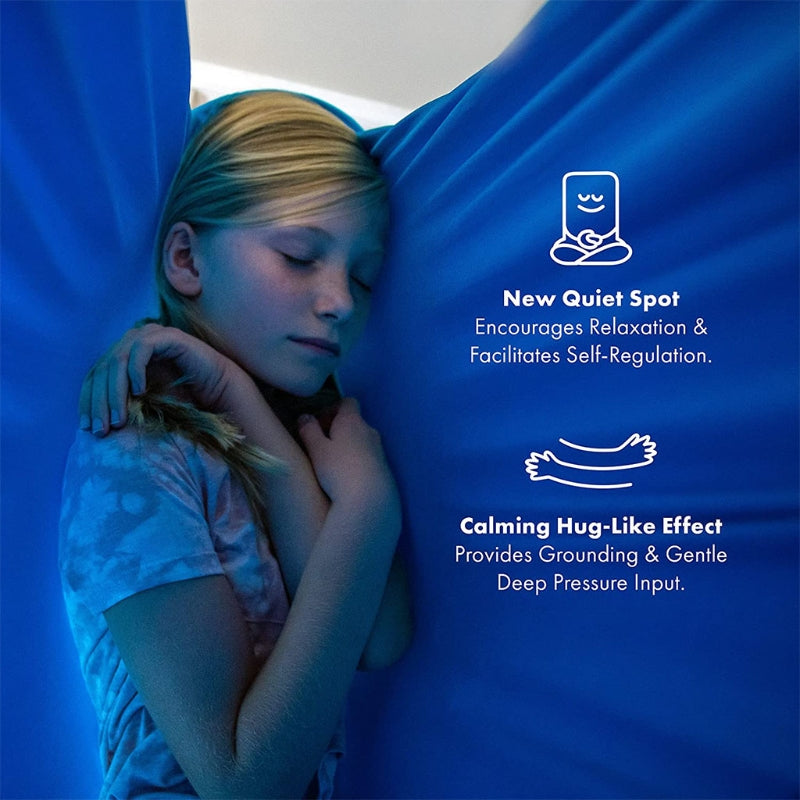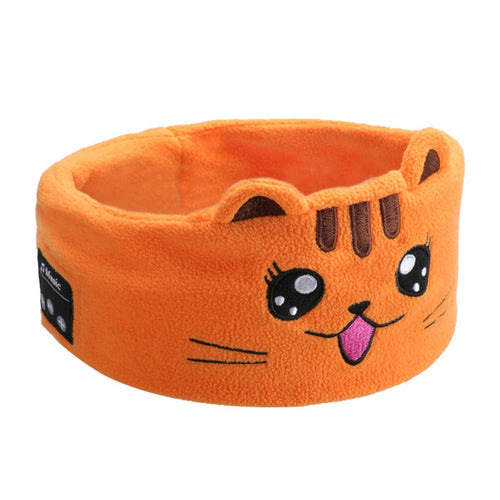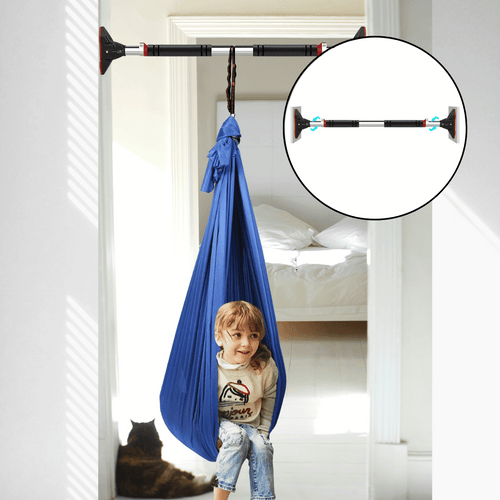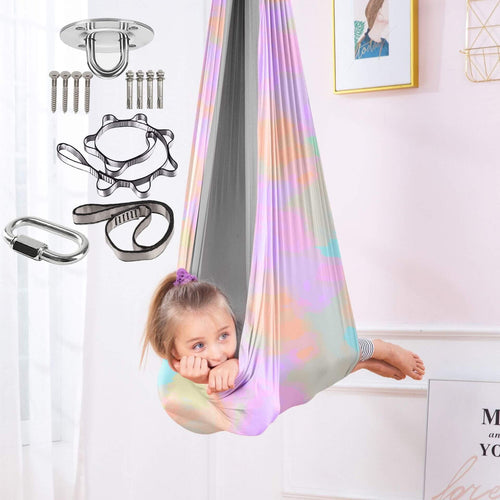Sensory swings have become an increasingly important tool in child therapy, offering a wide range of benefits that are supported by scientific research. These swings are not just a fun addition to a playroom but can be a crucial part of a child's development and well - being.
1. The Role of Sensory Swings in Child Therapy
Sensory swings provide a unique form of sensory input for children. They can mimic the feeling of movement and balance that a child experiences during normal activities like walking or running, but in a more controlled and focused way. For children with sensory processing disorders, these swings can help regulate their sensory systems. For example, a child who is overly sensitive to touch or movement may find the gentle rocking of a sensory swing to be calming and centering.
In a therapeutic setting, sensory swings can also act as a form of stress relief. Just like how adults might find relaxation in a hammock, children can unwind in a sensory swing. It provides a safe space where they can let go of tension and anxiety. Moreover, it can be a great tool for therapists to build rapport with their young clients. The novelty and fun factor of the swing can make the therapy session more engaging for the child, leading to better cooperation.
2. 10 Scientifically Supported Benefits
Anxiety Relief
One of the most significant benefits of sensory swings is anxiety relief. Scientific studies have shown that the rhythmic movement of the swing can trigger the release of endorphins in the body. Endorphins are natural hormones that act as mood elevators and painkillers. For a child who may be experiencing anxiety, whether it's due to school stress, social situations, or other factors, the gentle swinging motion can help soothe their nerves. It provides a repetitive and predictable movement that the child can focus on, taking their mind off their worries.
Improved Focus
Sensory swings can also enhance a child's focus. When a child is in the swing, they are required to maintain their balance and control their body movements. This physical engagement activates the proprioceptive system, which is responsible for our sense of body position and movement. By stimulating this system, the child becomes more aware of their body in space. This increased body awareness can then translate into better focus in other areas such as academic tasks. For example, a child who has difficulty sitting still and concentrating in class may find that spending some time in a sensory swing before school helps them be more attentive during lessons.
Physical Coordination
The swinging motion of the sensory swing challenges a child's physical coordination. As the swing moves, the child has to adjust their muscles to maintain balance and stability. This constant adjustment helps develop gross motor skills, such as balance, strength, and spatial awareness. It can be especially beneficial for children who are clumsy or have delays in their physical development. For instance, a child with cerebral palsy may use a sensory swing to gradually improve their muscle control and overall physical coordination.
Enhanced Vestibular System
The vestibular system, which is located in the inner ear, is responsible for our sense of balance and spatial orientation. Sensory swings provide a rich source of vestibular input. When a child swings, the fluid in their inner ear moves, sending signals to the brain about their position and movement. This stimulation helps develop and strengthen the vestibular system. A well - developed vestibular system is crucial for a child's overall motor development, as well as for their ability to perform complex physical tasks like riding a bike or climbing stairs.
Stress Reduction
Similar to anxiety relief, sensory swings are excellent for stress reduction. The act of swinging can have a hypnotic effect on the body and mind. It can slow down the heart rate, reduce muscle tension, and lower blood pressure. In a world where children are often exposed to various stressors, such as academic pressure, family issues, or peer relationships, having a sensory swing as a stress - relieving tool can be invaluable. It gives them an outlet to release pent - up stress in a healthy and non - destructive way.
Improved Sleep
The relaxation and stress - relief provided by sensory swings can also have a positive impact on a child's sleep. When a child is less anxious and stressed, they are more likely to fall asleep easily and have a more restful sleep. The gentle movement of the swing can mimic the rocking motion that many babies find soothing. For children with sleep problems, spending some time in a sensory swing before bedtime may help them relax and wind down, preparing their bodies and minds for sleep.
Emotional Regulation
Sensory swings can play a vital role in emotional regulation. For children who struggle with managing their emotions, the swing can provide a calming and grounding experience. The physical movement can help them process and express their emotions in a more controlled way. For example, a child who is feeling angry or frustrated may find that swinging helps them release that negative energy in a positive manner. It gives them a physical outlet for their emotions, rather than acting out inappropriately.
Increased Social Interaction
In a group therapy setting or in a playroom with other children, sensory swings can encourage social interaction. Children may take turns using the swing, learn to share, and communicate with each other about their experiences on the swing. This shared experience can help build social skills and relationships. It can also be a great ice - breaker for shy or withdrawn children, as the fun and engaging nature of the swing can draw them out of their shells.
Boosted Self - Esteem
As children improve their physical skills, such as balance and coordination, on the sensory swing, they gain a sense of accomplishment. This sense of achievement can boost their self - esteem. They feel proud of themselves for being able to do something new or better than before. For children who may have low self - esteem due to various reasons, such as academic difficulties or social challenges, the positive experiences on the sensory swing can be a much - needed confidence booster.
Enhanced Creativity
The unique sensory experience provided by the swing can also stimulate a child's creativity. The movement and the different sensations can inspire them to think outside the box. They may come up with new ideas, stories, or ways of playing while in the swing. It provides a different perspective and a break from the routine, which can be fertile ground for creativity to flourish.
3. Case Analysis: Success Stories of Parents or Therapists
There are numerous success stories from parents and therapists regarding the use of sensory swings. One parent, for example, had a child who was extremely hyperactive and had difficulty concentrating in school. After incorporating a sensory swing into their daily routine, the child showed significant improvement. The parent noticed that the child was able to sit still for longer periods during homework time and was more focused in class.
A therapist shared a story about a child with autism spectrum disorder. This child had trouble with social interaction and emotional regulation. The therapist introduced a sensory swing during therapy sessions. Over time, the child began to show more interest in interacting with others. The swinging motion seemed to calm the child down when they were feeling overstimulated, allowing them to better manage their emotions and engage in social exchanges.
Another parent had a child with sensory processing disorder who was very sensitive to touch and sound. The sensory swing provided a controlled sensory environment where the child could gradually become more comfortable with movement and touch. The child started to be less reactive to normal daily stimuli, and their overall quality of life improved.
4. Call to Action: Recommend SensoryHarbor Products
If you are looking for a high - quality sensory swing for your child or for your therapy practice, SensoryHarbor products are an excellent choice. Their sensory swings are designed with the latest research in mind, providing a safe and effective way for children to experience the benefits we've discussed. They come in a variety of sizes and styles to suit different needs and preferences. Whether you need a small swing for a home playroom or a larger, more durable one for a therapy center, SensoryHarbor has you covered.
So, don't wait any longer. Give your child the opportunity to experience the many benefits of a sensory swing. Explore the SensoryHarbor product line today and take the first step towards enhancing your child's development and well - being.







